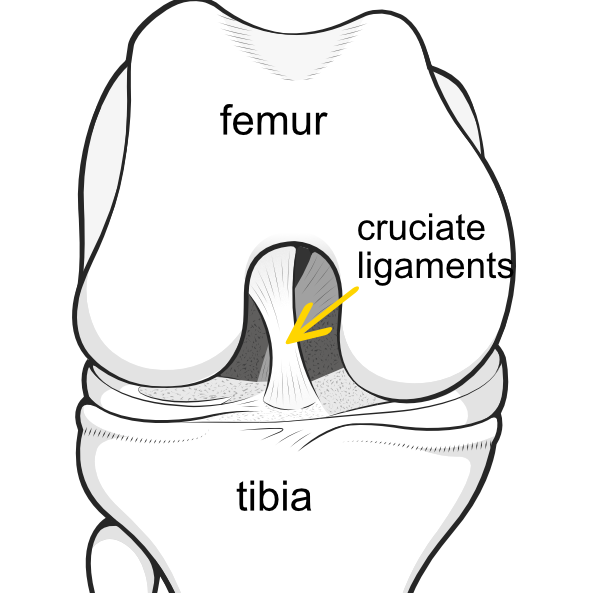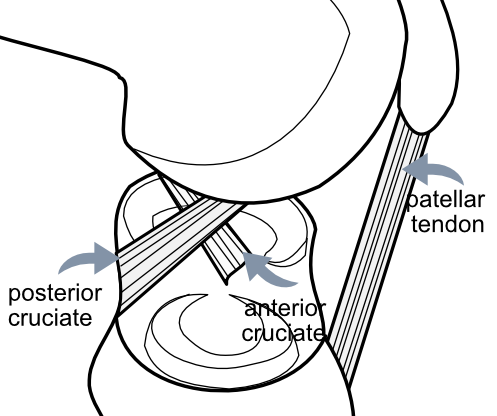The cruciate ligaments are the important central 'stays' of the knee joint, contributing significantly to the stability of the joint.
 Page updated January 2024 by Dr Sheila Strover (Clinical Editor)
Page updated January 2024 by Dr Sheila Strover (Clinical Editor)

The knee joint from the front. The word 'cruciate' means 'crossed', referring to the fact that the two cruciate ligaments cross over one another in the centre of the joint in the area called the 'notch'.

In this illustration, just to help you understand, the bones are distracted and you are looking from the side so that you can see the attachments of both anterior and posterior cruciate ligament.
What do the cruciate ligaments do?
The two cruciate ligaments tether the femur and tibia together while still allowing the knee to bend, stabilising the joint from frontwards and backwards forces. The posterior cruciate ligament (PCL) attaches to the tibia at the back of the knee and the anterior cruciate ligament (ACL) attaches to the tibia at the front of the knee.
Note in the sketch on the left the dynamic arrangement of the fibres of the ACL when the knee is bent and straightened. This is one of the reasons why ligament replacements do not do as good a job as the original ligament as this cannot be mimicked by the replacement.
What kind of injuries damage the cruciates?
The ACL is more commonly damaged than the PCL. Injury to the ligaments may be 'non-contact' or 'contact'. Injury to the ACL may occur while cutting and running to that side during a fast non-contact activity like football, or from landing from a twisting jump on that leg while the body still has momentum and continues to twist. Almost invariably, the person is unable to continue with the activity.
-
Quote:
In several...."studies, the injury rate in female athletes has ranged from two to six times the rate in male athletes..."
Citation: Spindler KP, Wright RW. Clinical practice. Anterior cruciate ligament tear. N Engl J Med. 2008 Nov 13;359(20):2135-42. doi: 10.1056/NEJMcp0804745. PMID: 19005197; PMCID: PMC3782299.
What are the symptoms of a torn anterior cruciate ligament?
During the injury event, the person may hear a loud 'pop', immediately followed by swellling of the knee and instability.
-
Quote:
"Injuries to the anterior cruciate ligament (ACL) of the knee are immediately disabling, take a significant amount of time to rehabilitate, are often associated with other concomitant articular injuries, and result in an increased risk of early onset posttraumatic osteoarthritis..."
Citation: Smith HC, Vacek P, Johnson RJ, Slauterbeck JR, Hashemi J, Shultz S, Beynnon BD. Risk factors for anterior cruciate ligament injury: a review of the literature - part 1: neuromuscular and anatomic risk. Sports Health. 2012 Jan;4(1):69-78. doi: 10.1177/1941738111428281. PMID: 23016072; PMCID: PMC3435896.
Does every torn cruciate ligament need surgery?
Every cruciate injury must be assessed on its own merits.
-
Quote:
"Patients with an ACL tear should be advised that surgical repair is not the only option for continuing sporting activities; a conservative approach consisting of a strict and vigorous rehabilitation plan can suffice.....The principal purpose of surgery is to enhance knee stability...."
Citation: Rodriguez K, Soni M, Joshi PK, Patel SC, Shreya D, Zamora DI, Patel GS, Grossmann I, Sange I. Anterior Cruciate Ligament Injury: Conservative Versus Surgical Treatment. Cureus. 2021 Dec 6;13(12):e20206. doi: 10.7759/cureus.20206. PMID: 35004026; PMCID: PMC8730351.
Do you ever really fully recover after cruciate surgery?
Cruciate ligament reconstructive surgery never fully restores the function of the original native ligament.
-
Quote:
"....Whatever therapy they choose....the risk of future knee lesions and osteoarthritis remains substantial, especially if they return to high-risk pivoting activities...."
Citation: Rodriguez K, Soni M, Joshi PK, Patel SC, Shreya D, Zamora DI, Patel GS, Grossmann I, Sange I. Anterior Cruciate Ligament Injury: Conservative Versus Surgical Treatment. Cureus. 2021 Dec 6;13(12):e20206. doi: 10.7759/cureus.20206. PMID: 35004026; PMCID: PMC8730351.
Forum discussions
- "non surgical recovery for "complex medial meniscus bucket handle tear""
Cruciate ligament injuries often go hand-in-hand with meniscus injuries
Relevant content -
 2017 - ACL Injury in Female Athletes - by Ms Michelle Boucher (Physician assistant)
2017 - ACL Injury in Female Athletes - by Ms Michelle Boucher (Physician assistant)
 2008 - Preventing ACL Injuries - by Miss Holly Silvers (Physiotherapist)
2008 - Preventing ACL Injuries - by Miss Holly Silvers (Physiotherapist)
 2006 - Timing of ACL reconstruction - by Dr Frank R Noyes (Knee Surgeon)
2006 - Timing of ACL reconstruction - by Dr Frank R Noyes (Knee Surgeon)
From the Journals -
- Journal interpretation - 2009 - Osteoarthritis in patients with anterior cruciate ligament rupture: A review of risk factors - interpreted by Dr Sheila Strover (Clinical Editor)